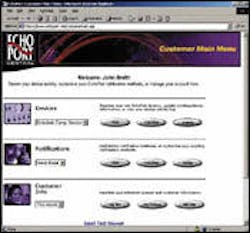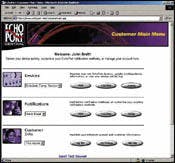Wireless Connectivity Creates New Opportunities
By 2003 it is estimated that 79.3 million wireless equipment-monitoring devices will be in use across the USA. The integration of the Internet with wireless communications is creating a wealth of new opportunities for intelligent data management in the water industry.
There are many applications where wireless technology would be beneficial to the water and wastewater industry. Sewage level readings, overflow alarm conditions, storage tank liquid levels, water content, control valve status, leak detection, chemical metering pumps, feed systems, pH sensors, sludge flow, and class B biosolids storage conditions could all benefit from this technology.
One of the pioneering companies of wireless data acquisition technology and device design, EchoPort Inc., has developed a simple system that can be retrofitted onto existing sensors. The retrofit system consists of three main elements: the EchoLink Remote Terminal Unit (RTU), the MicroBurst data transport, and a back end server system called EchoPort Central.
EchoPort Central is an intelligent data management portal. It was designed on the basic principles of security, reliability and scalability. This approach to hosting wireless applications ensures customers secure access to mission-critical data, while minimizing capital outlays. For utilities who wish to keep all their data internally and have in excess of 10,000 remote terminal units (RTUs) fielded, EchoPort also licenses EPC 2.0 for in-house installation.
The EchoLink 1550 is an intelligent data-sampling unit that contains a cellular modem, a real time clock for timing measurements, an EEPROM for configuration parameter storage and a high-speed micro-controller. This device samples data from the connected sensors and transmits information over the modem. Power consumption is low enough for battery-powered applications.
The device uses the existing cellular network infrastructure to transport data between plug-in sensors and the EchoPort Central back end. The link device has a large number of sensor interfaces to make it as generic as possible. These interfaces include 4-20 mA current loop, analog voltage levels, I2C, RS232, switch closure, pulse counting for totalizer-type sensors, and a built in thermistor for localized temperature readings.
The device uses the MicroBurst RF data network to transport the sensor data to the central server. Once at the central server, data can be sent to users over e-mail, pager, or by voice response unit. For machine-to-machine communications, the EPC server can send XML-formatted data or can be configured to interface to legacy back end systems for accounting, instant billing, etc.
The EchoPort Server consists of fault tolerant, high speed data servers connected to the Web, e-mail servers, fax servers, voice response servers and a large SQL database. This system enables owners of wireless-enabled devices to receive immediate notifications and track statistical data on a real time basis.
EchoPort Central has been designed to work with a variety of wireless transmission protocols and can interface with client companies via a wide assortment of notification tools. EchoPort is expanding its transport methods to include CDMA, GSM and other technologies.
EchoPort's system collects wireless data and serves it "web-style" for accounting, instant billing and other uses.

